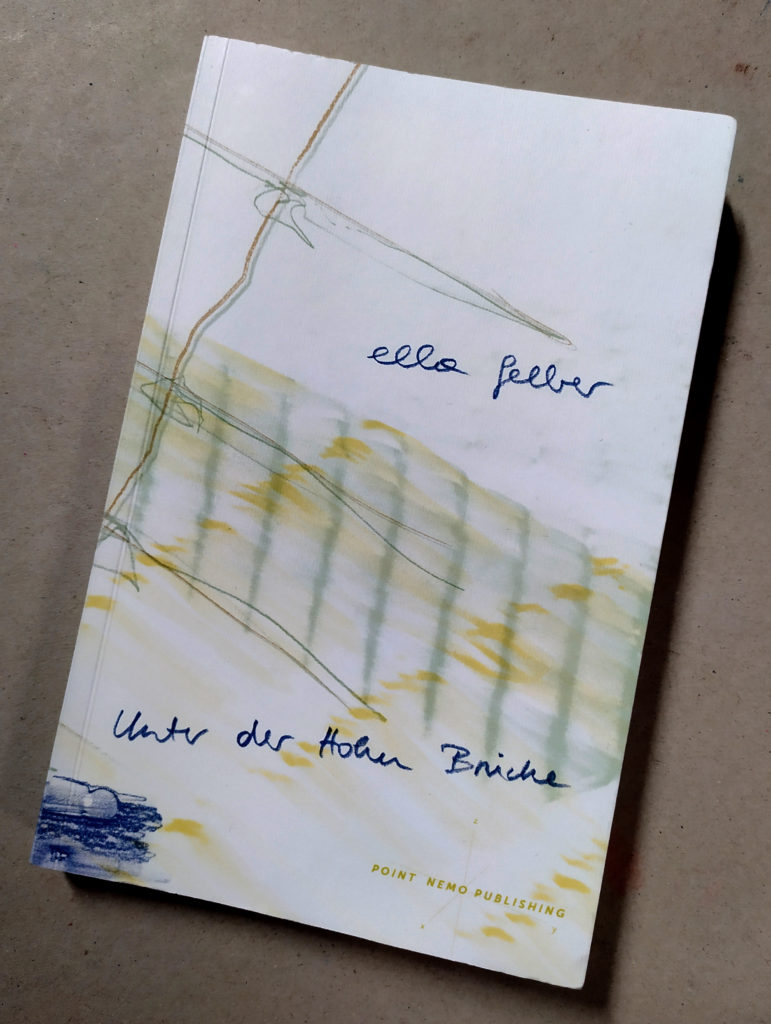
When I set up the blog on this version of my site, I had hoped to find time to share some selections from my reading, particularly related to my research. I haven’t managed before now, but one step at time. Today I’m happy to take a moment to look at reading Ella Felber on writing as architecture. Felber, an Austrian architect and poet, has recently published a book, Under der Hohen Brücke (Point Nemo Publishing, 2021), which attempts to find a shared space for poetry and architecture.
The book is divided into three main sections, one that is a sort of essay/inventory on writing as architecture, another as a “sequence of encounters,” and another as a sketchbook of ideas connecting poetry and the built environment, particularly around the Tiefer Graben and the Hohe Brücke bridge in Vienna. On the whole, the book collects thoughts, notions, references, etc., rather than working more linear fashions, and Felber explicitly invites readers to enter the text from any one of multiple entry points. This has been helpful for me, since a bit more than a third of the book is written in a language I don’t speak, German (I’ll be working on getting some help to make some rough translations of those passages in the near future).
Since I am currently working on creative writing practices and spatial design, the section of the book on writing as architecture is naturally of particular interest to me. I’m still thinking through my notes on what Felber writes, and considering how she makes her argument for architectural writing, but two themes stand out for me in this essay/inventory: creation and knowing.
For the former, she’s interested in examining texts that make space or behave as spaces themselves, and for this she looks at authors like Italo Calvino, Dung Kai-cheung, and Clarice Lispector, while also thinking through her own practice. I particularly appreciate how she brings out structure in her readings of these texts, while also making strong claims on the concept of iteration. She herself iterates in writing, working through this idea of repetition with variation, and the ways in which it creates value and, often, creates space or place. Each repeat, in context, reveals itself as intrinsically new. Felber references Kierkegaard on repetition, though her thinking works well alongside Deleuze, James Snead, and others. For writing practices, the idea of reiterating through rewriting is attractive.
In terms of knowledge, she brings up an important reference for me, Viktor Shklovsky, the Russian literary theorist, and his notion of estrangement as a means of making the familiar strange once again. In these passages, which also touch on Georges Perec’s writing about/through/as space, Felber really strikes at architectural knowing, or at least the radical possibilities for spatial knowledge when working as a writer-architect.
By interrupting our habits enstrangement causes a moment of disturbance – an ‘n’ – an instability, which can in turn change our perception. We recognise and reconfigure how we observe, we might even unlearn some of our habits, and thus remain receptive to the poetics of everyday life.
Ella felber
I’ll have more to say about estrangement in the future, but I agree with Felber in terms of its importance for a shared poetic-architectural space and think it can be argued as a principal poetic operation in the production of new knowledge: make strange so as to see a space again, as if for the first time.
Of the questions I am posing myself right now, several relate to the form of the codex book and its relation to the built edifice, and how Felber deliberately leaves this particular book open and (seemingly) unfinished (even if it contains a finalizing postscript). Writing as Architecture is a tricky subject, since it runs a risk that all crossovers eventually confront, one in which the result dissatisfies both the communities built around writing and the communities written around building (I am reminded of Manuel DeLanda risking the ire of philosophers of multiple camps as he tries to translate Deleuze into an analytical philosophy context). I think Felber makes some very smart decisions, however, to claim incompletion, imperfection, and contingency as signs for her work, so that readers are invited not to see the book as a perfected object, but a place into which one enters as often as desired. In this sense, I think she offers both the theory and the demonstration in the same gesture. I hope, however, that this is an indication, as well, that she has more work forthcoming, as this feels like a first meaningful foray into something potentially life-defining. To be seen!
Special thanks to writer and friend Jeffrey Palms, who sent me copy of Felber’s book.